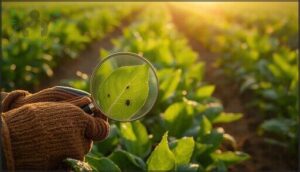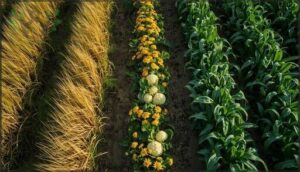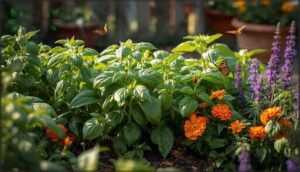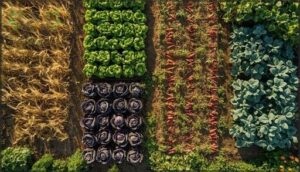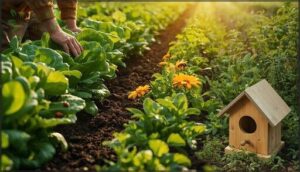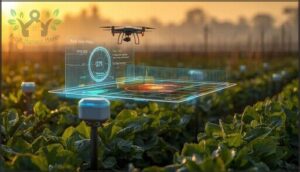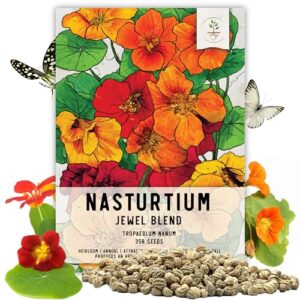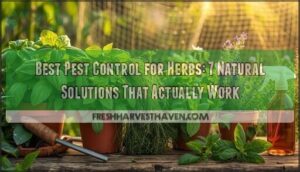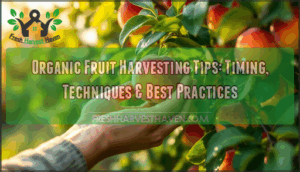This site is supported by our readers. We may earn a commission, at no cost to you, if you purchase through links.
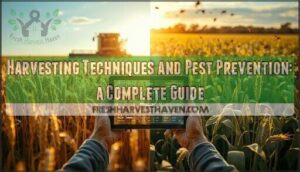
Every growing season, farmers lose an average of 18-20% of their potential yield to pest damage, but those who master the connection between harvesting techniques and pest prevention cut those losses in half. The secret isn’t necessarily more pesticides or expensive interventions—it’s understanding that when you harvest can be just as important as how you harvest.
Pests follow predictable life cycles, and your harvest timing either works with these patterns or against them. By aligning your operations with pest behavior, weather triggers, and crop vulnerability windows, you can disrupt infestations before they establish, protect your yields naturally, and reduce your reliance on chemical controls.
The strategies ahead combine time-tested agricultural wisdom with modern precision tools to help you turn harvest management into one of your most effective pest prevention measures.
Table Of Contents
- Key Takeaways
- Strategic Harvest Timing for Pest Reduction
- Monitoring and Identifying Crop Pests
- Implementing Trap Cropping Techniques
- Companion Planting for Pest Prevention
- Crop Rotation and Diversity Strategies
- Sustainable Pest Management Practices
- Optimizing Harvest Hygiene and Equipment
- Leveraging Technology for Pest and Harvest Control
- Top 6 Tools and Products for Harvest and Pest Control
- Frequently Asked Questions (FAQs)
- How do you control pests in a crop?
- What are the methods of pest control?
- Is IPM a single pest control method?
- Which pest control is best?
- Do agricultural growers identify pests before spraying?
- What is integrated pest management (IPM)?
- How do soil amendments affect pest populations?
- What role does irrigation timing play in pest control?
- Can mulching reduce pest pressure during harvest season?
- What are signs of pest resistance to control methods?
- Conclusion
Key Takeaways
- Strategic harvest timing aligned with pest life cycles, weather patterns, and growing degree days can reduce pest damage by 15-40% and cut insecticide applications by up to 21% while protecting crop quality.
- Dawn harvesting and late-season timing create natural pest management windows that slash pest activity by 50%, reduce losses by 28%, and lower drying costs by 17% compared to conventional schedules.
- Integrated pest management combining trap cropping, companion planting, and crop rotation disrupts pest populations by up to 70% while reducing pesticide use by 50% and maintaining or improving yields by 41%.
- Modern precision tools including IoT sensors, AI forecasting, and pest prediction models achieve 85-96% accuracy in detecting threats, enabling targeted interventions that cut chemical use by 30% while improving decision-making speed.
Strategic Harvest Timing for Pest Reduction
Timing your harvest strategically can make the difference between a healthy crop and one ravaged by pests. Understanding pest life cycles and environmental triggers allows you to harvest when pest pressure is naturally lower, reducing damage and minimizing the need for interventions.
Let’s explore four practical approaches that help you time your harvest to stay one step ahead of common crop pests.
Aligning Harvest With Pest Life Cycles
When you match your harvest timing to pest cycles, you can cut infestations dramatically. Here’s how strategic harvest timing works:
- Target aphid multiplication phases – Aphids reproduce every 7 days in warm weather, so harvesting before generational overlap prevents population explosions.
- Interrupt migration cycles – Early harvest stops winged adults from spreading to neighboring crops.
- Catch pest dormancy windows – Timing harvest during pupal stages reduces pest populations by up to 22%.
- Use targeted windows strategically – Aligning with pest activity patterns decreases damage by 15–40%. Farmers can also use weather analytics to detect environmental triggers that favor pest infestations.
Using Weather Forecasts to Predict Pest Activity
Weather patterns directly shape pest behavior, giving you a powerful forecasting edge. Temperature impacts insect development rates—many pests double their activity with every 10°C rise. Rainfall effects spread disease spores, while wind dispersal carries aphids and other pests miles from their origin. Modern pest prediction models integrate these factors with growing degree days calculations, achieving accuracy rates above 73%. For more precise interventions, farmers can leverage a web-based forecasting system.
Here’s what monitoring weather patterns reveals:
| Weather Factor | Pest Response | Action Window |
|---|---|---|
| Temperature 25-30°C | Accelerated reproduction cycles | Harvest before population surge |
| Humidity >60% | Increased disease transmission | Apply preventive measures early |
| Low wind speeds | Pest settlement on crops | Schedule interventions promptly |
| Rainfall spikes | Spore dispersal events | Monitor for disease symptoms |
| Temperature Strategic harvest timing—especially at dawn—cuts pest activity by up to 50%, slashes losses by 28%, and boosts both yields and fuel efficiency |
Here are three measurable advantages you can’t ignore:
- Enhanced crop quality: Dawn harvesting increases alfalfa protein content by 12% and reduces wheat shattering losses by 21% compared to afternoon operations.
- Lower pest management costs: Combining dawn and late-season strategies with IPM integration reduces annual insecticide applications by 21% and post-harvest treatments by 27%.
- Improved harvest economics: Late-season timing lowers drying costs by 17% on average, while strategic harvest aids cut completion time by 10 days.
Calculating Growing Degree Days (GDD) for Timing
Beyond clock-watching, you’ll gain precision when you calculate growing degree days to forecast pest emergence and harvest readiness. Start by averaging daily max and min temperatures, then subtract your crop’s base temperature—usually 50°F for corn, 55°F for cucumbers. Accumulate these GDD values throughout the season to pinpoint when pests reach vulnerable stages and your crops hit prime harvest time.
| Crop | Base Temperature | Key GDD Achievement |
|---|---|---|
| Corn | 50°F | 2,700 GDD to maturity |
| Soybean | 50°F | 2,200–2,500 GDD range |
| Cucumber | 55°F | 1,200 GDD harvest window |
Track Colorado potato beetle egg laying at 150–200 GDD and European corn borer emergence at 200–250 GDD. Regional GDD variations shift these thresholds, so monitor local temperature trends and use online calculators or IoT sensors for real-time tracking.
This temperature-based approach sharpens your pest prediction accuracy and harvest timing optimization, cutting losses by targeting interventions precisely when pests are most vulnerable.
Monitoring and Identifying Crop Pests
You can’t manage what you don’t monitor, and regarding crop pests, early detection makes all the difference between a minor nuisance and a major loss. Knowing which insects are visiting your fields, when they arrive, and how their populations shift throughout the season gives you the upper hand in protecting your harvest.
Here are four practical strategies to help you stay one step ahead of the pests threatening your crops.
Creating a Seasonal Pest Journal
Think of your seasonal pest journal as your farm’s early warning system—record keeping that turns past patterns into future protection. More than 80% of dedicated gardeners find journaling rewarding for tracking pest cycles and improving pest prediction. Digital vs. analog formats both work; choose what fits your routine:
- Document pest activity dates, weather conditions, and treatment results
- Track pest populations across seasons to spot emerging trends
- Support Journaling for IPM by capturing data that guides research applications
Journal data recording enhances your ability to time interventions precisely, reducing crop damage by up to 25%.
Photographing and Identifying Unfamiliar Insects
How do you capture the details that matter when you spot something unexpected crawling through your crops? Use your camera’s macro imaging mode to get within inches of insect pests, filling the frame to reveal identifying features.
Steady your elbows, shoot from multiple angles, and use flash in dim light—sharp photos make pest identification through image analysis accurate.
Clear insect photography turns guesswork into confident monitoring of garden pests and identifying common crop pests.
Utilizing Pest Prediction Models and Apps
How confident can you be in your spray decisions when pest forecasting apps track 45 distinct pests across millions of acres? Digital pest prediction models using real-time weather data achieve 85–92% accuracy, supporting integrated pest management and cutting unnecessary treatments.
With over 6,000 growers already utilizing pest prediction models in their monitoring routines, you’re tapping proven technology that reduces crop losses and sharpens economic impacts across your operation.
Tracking Pest Trends in Neighboring Farms
Imagine boosting profits by $148 an acre just by staying plugged into your neighbors’ data. Networked pest monitoring lets you track shifting pest populations as they move across your area, with automated surveillance systems delivering timely updates.
Thanks to data sharing benefits and regional early warnings, you can time interventions with confidence and adapt your pest management as landscape drivers shift pest activity.
Implementing Trap Cropping Techniques
Trap cropping works like setting up a distraction—you plant something pests love even more than your main crop, drawing them away before they cause real damage. The strategy depends on choosing the right plants, placing them where they’ll intercept pests effectively, and timing everything so your trap is irresistible when it matters most.
Here’s how to put these techniques into practice on your farm.
Choosing Effective Trap Crops
You’ll want to select trap crops based on species-specific attraction to your target pests, not just general appeal. Consider these proven options when implementing trap crops:
- Napier grass and sorghum divert over 80% of stemborer moths from maize
- Turnip rape attracts flea beetles four times more effectively than cauliflower
- Snap beans reduce Mexican bean beetle populations in soybeans by 70%
Allocate 5–20% of your field area to boost pest diversion while maintaining economic outcomes.
Timing and Placement for Maximum Diversion
Best planting time starts 2–4 weeks before your main crop, ensuring trap crops reach peak attractiveness right when pests arrive. Phenology synchronization—matching trap crop bloom with pest activity—delivers sustained effectiveness through staggered planting and minimizing pest damage.
Position them 8–12 feet from your main planting in two to three perimeter rows for strategic harvest timing. This spatial arrangement, covering 5–20% of your field proportion, intercepts pests before they reach your cash crop.
Integrating Sacrificial Plants Around Field Perimeters
Strategic placement transforms sacrificial perimeter plants into powerful pest management strategies. Three rows spaced six feet apart create an effective barrier, diverting pests from main harvest before they reach your cash crops—studies show up to 21% economic yield increase in protected fields. Sacrificial plant diversity strengthens trap cropping performance, while regular pest removal enhances overall efficacy.
Your boundary placement strategy should cover all field edges:
- Position sacrificial borders on all sides rather than just windward edges for 12% better pest interception
- Maintain weekly monitoring schedules to reduce secondary infestation risk by 80%
- Mix species within perimeter plantings—companion planting diversity improves diversion by 17% over single-species strips
- Space rows consistently at six-foot intervals to optimize pest populations concentration while protecting interior crops
Companion Planting for Pest Prevention
Companion planting works like building a natural neighborhood where certain plants look out for each other by repelling pests or attracting beneficial insects. When you thoughtfully pair your crops with the right companions, you create a living defense system that extends your harvest window and reduces pest pressure without chemicals.
Let’s explore how to select the right plants, leverage diversity to protect your crops, and design layouts that amplify this natural protection.
Selecting Pest-repelling Companion Plants
When selecting companion plants for pest management, you’ll want to focus on proven combinations that create a natural defense system in your garden ecosystem. Basil and tomatoes work well together—trials show basil repels up to 52% of aphids while also deterring whiteflies.
Consider these effective pairings:
| Companion Pair | Primary Pest Controlled |
|---|---|
| Basil and Tomatoes | Aphids, whiteflies |
| Marigold Benefits | Root-knot nematodes |
| Nasturtium Uses | Flea beetles, aphids |
| Onion and Carrots | Carrot fly |
Aromatic borders featuring garlic and chives reduce aphid infestations by 40% on lettuce and brassicas. These natural repellents attract beneficial insects while disrupting pest behavior, creating a balanced garden ecosystem that requires fewer chemical interventions.
Enhancing Harvest Windows With Plant Diversity
Beyond pairing individual plants for pest control, you’ll extend your harvest windows by integrating multiple species that mature at different rates. Species complementarity and resource partitioning allow cool-season and warm-season crops to share space efficiently, spreading harvest demands over weeks rather than days.
This diversity increases biomass production while reducing vulnerability to pest outbreaks—when herbivores target one crop, others continue thriving. The result? Income stabilization through longer market availability.
Designing Mixed Planting Layouts for Protection
Spatial arrangement matters as much as plant diversity in companion planting. Drawing on field trial data, consider these layouts:
- Interspersed rows alternate main crops with pest-repelling species, confusing pests while attracting beneficial insects
- Border plantings use trap crops to intercept pests before they reach your harvest
- Cluster designs group beneficial combinations like tomato-basil or carrot-onion
- Vertical layering creates microclimates supporting natural pest predators
These ecological benefits extend beyond pest management into improved crop rotation efficiency.
Crop Rotation and Diversity Strategies
Crop rotation isn’t just about keeping your soil healthy—it’s one of the most effective ways to break pest cycles before they become a problem. When you change what you plant in each area year after year, you create natural barriers that pests can’t easily overcome.
Let’s look at three proven strategies that’ll help you disrupt pest patterns, strengthen your soil, and build long-term resilience into your growing system.
Disrupting Pest Life Cycles With Crop Rotation
Crop rotation acts like hitting reset on the pest life cycle. When you rotate away from a pest’s primary host crop, you can reduce host-specific insect populations by up to 70%, while nematode numbers drop over 60% with just one to two years of non-host crops.
This agricultural practice strengthens soil health, cutting pesticide use by roughly 50% and boosting pest management without harsh chemicals.
Rotating Crops With Varying Pest Vulnerabilities
When crops share the same pest vulnerabilities, you’re leaving the welcome mat out. Rotation benefits shine when you pair crops with non-overlapping pest profiles, delivering economic impacts that matter for sustainable farming.
Strategic pairings maximize pest lifecycle disruption:
- Rotate cereals with legumes to cut nematode populations by 60% while boosting soil health
- Switch corn with soybeans to slash corn rootworm numbers substantially
- Follow brassicas with non-crucifer crops to suppress soil pathogens naturally
- Alternate deep-rooted and shallow-rooted species for enhanced pest management
- Plan three-year cycles to address severe infestations effectively
Improving Soil Health and Pest Resilience
Building soil biodiversity through rotation strengthens your farm’s natural defenses. You’ll see microbial interactions flourish as organic matter increases, improving nutrient cycling while cutting reliance on reduced pesticides.
Fields practicing diverse rotations maintain 80% higher pest resistance, supporting beneficial insects and natural repellents. This enhanced soil health reduces disease outbreaks and chemical dependency, letting natural pesticides from thriving microbes do the heavy lifting.
Sustainable Pest Management Practices
Sustainable pest management doesn’t mean sacrificing effectiveness—it means working smarter with nature rather than against it. You can protect your crops and reduce your environmental footprint by choosing methods that support beneficial organisms and minimize synthetic chemicals.
Let’s explore three approaches that balance productivity with long-term soil and ecosystem health.
Organic and Botanical Pesticide Options
When synthetic chemicals feel like overkill, organic pest control offers a gentler path forward. The global organic pesticides market is projected to reach $275 billion by 2032, driven by proven botanical efficacy and reduced environmental impact. Natural pesticides like neem oil, garlic spray, and chili spray deliver results while protecting beneficial insects—a win for your crops and the ecosystem.
Common types you’ll want to explore:
- Pyrethrins – Derived from chrysanthemums, these natural pesticides control a broad spectrum of insects with minimal residual impact
- Azadirachtin (Neem oil) – Disrupts pest feeding and reproduction while maintaining safety for pollinators and natural predators
- Garlic spray – Repels aphids, beetles, and other soft-bodied insects through its pungent sulfur compounds
- Chili spray – Capsaicin-based formulas deter chewing insects without harming beneficial arthropods
- Limonene – Citrus-derived compound that breaks down pest exoskeletons, offering fast-acting control with low toxicity
Usage patterns show organic fields have about 30% lower pesticide application rates than conventional operations. That’s a significant reduction that translates to healthier soil, cleaner water, and safer produce. Botanical treatments cause fewer adverse effects on natural enemies, allowing beneficial insect populations to bounce back quickly after application.
Market growth reflects this shift in thinking. More growers are discovering that plant-derived pesticides—when applied correctly—match synthetic options in effectiveness while dramatically reducing toxicity risks. Studies confirm that botanical insecticides achieve pest mortality rates between 33% and 41% in field trials, comparable to many conventional products but without the heavy ecological footprint.
Conservation Biological Control Methods
You can utilize nature’s pest control team by creating a habitat where beneficial insects thrive. Conservation biological control enhances natural predators—ladybugs, parasitic wasps, and spiders—that reduce pest populations by up to 73%.
Natural enemy effectiveness delivers $13 billion in annual pest suppression value in the USA alone. Adoption rates climb as wildflower strips and hedgerows boost biocontrol agents by 40–60%, offering economic impacts through yield increases exceeding 25% while addressing implementation challenges like regional adaptation.
Minimizing Chemical Interventions
Reducing chemical interventions isn’t just environmentally responsible—it’s economically smart. Integrated pest management cuts pesticide use by 69% while boosting yields by 41%, demonstrating that biological control and organic options deliver results without compromising productivity.
- Threshold-based programs reduce insecticide applications by 44% while maintaining pest control effectiveness
- Biocontrol effectiveness reaches 55% pest reduction and 60% crop damage decrease using natural predators
- Soil health improvements from fewer chemicals boost long-term farm profitability
- Consumer demand drives the shift, with 75% concerned about environmental impacts
Economic benefits include $225 per hectare savings in sustainable agriculture systems.
Optimizing Harvest Hygiene and Equipment
Good hygiene during harvest isn’t just about cleanliness—it’s your first line of defense against spreading disease and contamination throughout your crop. Clean tools and careful handling protect the quality of everything you’ve worked so hard to grow.
Let’s walk through the essential practices that’ll keep your harvest safe from field to storage.
Preventing Disease Spread During Harvesting
Preventing disease spread during harvesting starts with timing harvest during dry conditions to reduce pathogen mobility by up to 60%. You’ll also want to minimize contact and mechanical damage, as bruising increases fungal infections by providing entry points.
Consider these essential hygiene protocols:
| Practice | Technique | Impact |
|---|---|---|
| Timing harvest | Harvest during dry weather, early morning | 60% lower disease spread |
| Worker hygiene | Clean gloves, handwashing stations | 40% less pathogen transmission |
| Minimize damage | Gentle handling, reduced drop heights | 30-50% less post-harvest decay |
| Field sanitation | Remove plant debris immediately | 40% lower disease inoculum |
| Sorting produce | Remove diseased crops promptly | 50% reduction in spoilage spread |
Training your workers to recognize symptomatic plants improves removal of infection sources by 45%, while restricting unnecessary field access cuts infection incidence by 25%.
Maintaining and Sanitizing Harvesting Tools
Clean tools prevent disease spread just as effectively as careful timing. You’ll need to establish a regular tool cleaning frequency that fits your operation—daily sanitization during peak harvest, and more often when moving between fields or plant varieties.
Here’s your practical sanitization routine:
- Remove visible soil and debris before applying sanitizer solution verification methods
- Use Lysol wipes or 50-150 ppm chlorine solutions compatible with your tool materials
- Scrub with color-coded brushes to guarantee cross-contamination prevention between crops
- Rinse thoroughly and air-dry sharp tools to maintain cutting performance
- Document each cleaning session to track sanitation documentation impact and improve your hygiene protocols
Contaminated tools can undo your best harvesting techniques, so make sanitization non-negotiable.
Safe Crop Handling and Storage Practices
Beyond clean equipment, your crop storage techniques determine whether pests multiply or disappear. Harvest hygiene starts in the field—avoid picking on rainy days or when dew blankets crops, since moisture invites disease.
Storage sanitation means cleaning all old grain from facilities before new harvests arrive; residual material fuels infestation losses that can hit 25% in improperly managed storage conditions with poor postharvest handling.
Leveraging Technology for Pest and Harvest Control
Modern technology has fundamentally changed how you can monitor pests and schedule harvests on your farm. From sensors that track real-time field conditions to artificial intelligence that forecasts pest pressures before they become problems, these tools give you precision that wasn’t possible even a few years ago.
Let’s look at three key technological approaches that can strengthen your pest management and harvest timing decisions.
Using IoT Sensors and Smart Traps
Smart agriculture technology is transforming how you approach pest management. IoT sensors and traps deliver automated pest alerts in under 15 minutes, detecting activity with up to 98.6% accuracy.
You’ll receive real-time data on temperature, humidity, and pest presence through remote monitoring systems. Sensor data integration facilitates predictive pest analytics, helping you make informed decisions about precision spraying.
This targeted approach reduces pesticide use by 30% while decreasing manual scouting time considerably.
AI-enabled Pest Forecasting and Harvest Scheduling
When AI accuracy reaches 96% in pest detection, you’re looking at a major shift for your farm. Predictive modeling and data integration now enable strategic harvest timing with precision agriculture tools that boost yields up to 30%. Here’s what AI-driven systems deliver:
- Early pest outbreak warnings with 90%+ forecasting accuracy
- Optimized harvest windows aligned with pest life cycles
- Growing degree days calculations for perfect timing
- Reduced pesticide use through targeted interventions
- Real-time adjustments based on environmental factors
These smart agriculture technology advances support integrated pest management while creating significant economic impacts through reduced losses and improved crop quality—trends that’ll shape farming’s future.
Data Analytics for Real-time Decision-making
Real-time dashboards transform your farm operations when they connect IoT sensors, satellite imagery, and predictive analytics into actionable insights. With over 40 million ground sensors now operational globally, you’ll see yield improvement averaging 13% through resource optimization and smart agriculture technology.
This tech adoption enables integrated pest management while reducing water use by 12-19%, giving you stronger pest control strategies and effective risk mitigation for precision agriculture success.
Top 6 Tools and Products for Harvest and Pest Control
You don’t need expensive equipment to improve your harvest efficiency and pest control outcomes. A few well-chosen tools can make your work easier while supporting the sustainable strategies we’ve discussed.
Here are six practical products that address common challenges during harvest and pest management.
1. LHKNL Rechargeable LED Headlamp Flashlight 2 Pack
When early morning harvesting calls you to the field before dawn, you’ll find that hands-free lighting changes everything about your pest prevention workflow. The LHKNL Rechargeable LED Headlamp delivers 1200-1300 lumens of headlamp brightness with eight lighting modes, including red light options that won’t attract insects during those critical pre-dawn hours.
Its waterproof durability (IPX4 rating) withstands wet conditions, while the adjustable comfort of its elastic band and 60° rotatable head keeps you focused on safe harvesting practices without wrestling equipment.
2. NatureZ Edge Marigold Seeds Mix
If you’re looking to turn your garden into a living pest control system, the NatureZ Edge Marigold Seeds Mix offers over 5,600 seeds that establish natural repellents through companion planting. These French marigolds emit thiophenes from their roots, cutting nematode infestations by up to 90% while their scent deters aphids and whiteflies.
With seed germination rates between 85-90% and blooms appearing within 60-70 days, you’ll attract beneficial insects like ladybugs that boost pollination rates by 25%.
Their soil health impact extends beyond harvesting marigolds—tilled residues suppress pathogens by 63% for your next crop.
3. AeroFarms Spicy Microgreens Arugula Mustard
When indoor harvesting meets vertical farming, you eliminate pest prevention challenges entirely—and that’s exactly what AeroFarms Spicy Microgreens Arugula Mustard demonstrates. Their pesticide-free growth system achieves 390 times greater productivity per square foot than field farming while using 95% less water.
You’re getting nutrient density that’s five times higher than mature greens, with harvest cycles completing in just 10-14 days.
This sustainable production method requires zero chemical interventions for crop protection, proving that integrated pest management starts with reimagining where and how you grow food.
4. KSIPZE RGB Music Sync LED Lights
While RGB pest attraction isn’t this product’s primary function, KSIPZE LED strips offer surprising harvest-related benefits through energy efficiency and smart scheduling. You’ll appreciate the app-controlled timing features that automate lighting cycles for extended workdays, while music synchronization adds ambient comfort during long harvest sessions.
At under $9 for 100 feet with a wide installation range, these lights reduce energy costs by roughly $10 monthly. Though marketed for home décor, their preventative measures for crop quality include improving visibility during dawn harvesting—a proven pest management window when insect activity peaks.
5. Jewel Mix Nasturtium Edible Flower Seeds
Beyond ambient lighting, living pest control comes from Jewel Mix Nasturtium—a strategic companion planting choice for your vegetable garden. These edible flowers extend to trap cropping: position them around vulnerable crops to divert aphids and squash bugs, preventing pest damage before it escalates.
Their peppery nasturtium flavor profile adds culinary value while attracting beneficial insects.
Follow seed germination tips by avoiding oversoaking, then apply harvesting best practices—collect open blooms at dawn and limit leaf removal to one-third per session, maintaining plant vigor throughout the 50–70 day growing cycle.
6. Fiskars Herb Garden Snips Shears
Once you’ve diverted pests with trap crops, precision cutting with the right harvesting equipment protects your yields. Fiskars Herb Garden Snips feature a 5-inch stainless steel blade and ergonomic design that reduces hand fatigue through Easy Action springs—essential for repetitive harvesting techniques.
Their pointed tips deliver clean cuts that minimize pest damage by preventing tissue crushing, a common entry point for disease. Dishwasher-safe certification aids hygiene benefits through thorough sanitation, preventing cross-contamination between plants.
User feedback consistently rates these snips 4.8 stars, with blade maintenance requiring only seasonal sharpening to sustain clean equipment performance.
Frequently Asked Questions (FAQs)
How do you control pests in a crop?
You’ll control pests using integrated pest management, combining cultural control practices like crop rotation with biological pest control through natural predators. This approach minimizes chemical pesticide usage while maintaining effective pest management across your fields.
What are the methods of pest control?
You can manage pests through chemical pesticides, biological control using natural predators, trap cropping to divert insects, crop rotation, and Integrated Pest Management (IPM) strategies—which reduce pesticide use by up to 50%.
Is IPM a single pest control method?
No, Integrated Pest Management isn’t a single pest control method. It’s a thorough approach that combines biological, cultural, physical, and chemical tactics. You’ll use pesticides only when pest populations exceed established thresholds.
Which pest control is best?
There’s no universal “best” pest control method. Integrated Pest Management (IPM) combines biological pest control, chemical pest control when needed, and cultural practices, offering sustainable options with strong biocontrol efficacy while addressing chemical resistance and long-term impacts cost-effectively.
Do agricultural growers identify pests before spraying?
Most agricultural growers do identify pests before spraying—around 80% of conventional and 88% of organic growers scout first. However, 13% still react to visible problems without formal pest identification or scouting.
What is integrated pest management (IPM)?
You’ll reduce pesticide use by combining biological controls, cultural practices, and monitoring to manage pests economically.
IPM benefits include lower costs, healthier ecosystems, and sustainable pest control through science-based decision-making and targeted interventions.
How do soil amendments affect pest populations?
Soil amendments shape pest populations in complex ways. Organic fertilizers boost soil microbes and crop health, often strengthening pest resistance.
However, nitrogen-rich amendments can attract certain insects, so balanced soil fertility and healthy soil ecology matter most.
What role does irrigation timing play in pest control?
When you irrigate affects pest pressure greatly. Early morning watering lets foliage dry quickly, reducing fungal diseases and humid microclimates pests prefer.
Proper soil moisture balance strengthens crop stress resilience and root health, enhancing integrated pest management.
Can mulching reduce pest pressure during harvest season?
Yes, mulching substantially lowers pest pressure during harvest season by creating a mulch pest barrier, boosting natural enemy populations, and improving soil health impact.
Crop-specific effects and mulch material choice determine effectiveness across different agricultural practices.
What are signs of pest resistance to control methods?
When pests suddenly reappear days after spraying, you’re witnessing treatment failure—a telltale sign of resistance.
Watch for behavioral changes in feeding patterns, increased crop damage despite applications, and monitoring data showing reduced susceptibility to your usual control methods.
Conclusion
The next time pests threaten your fields, remember: your harvest schedule holds more power than you might think. By weaving together strategic timing, vigilant monitoring, and the natural defenses of companion plants and crop rotation, you’re not just reacting to infestations—you’re preventing them.
Mastering harvesting techniques and pest prevention means working smarter, not harder, turning the rhythm of your farm into a shield that protects your yields season after season.
- https://www.frontiersin.org/journals/insect-science/articles/10.3389/finsc.2024.1324044/full
- https://farmonaut.com/blogs/aphid-life-cycle-time-2025-rapid-pest-control-tips
- https://courses.cit.cornell.edu/ipm444/lecture_notes/05cultural_control/harvest_manipulation.html
- https://www.nifa.usda.gov/about-nifa/impacts/climate-change-drive-surge-insects-attack-almonds-peaches-walnuts
- https://ipm.ucanr.edu/agriculture/alfalfa/harvest-scheduling-and-harvest-impacts-on-ipm/

